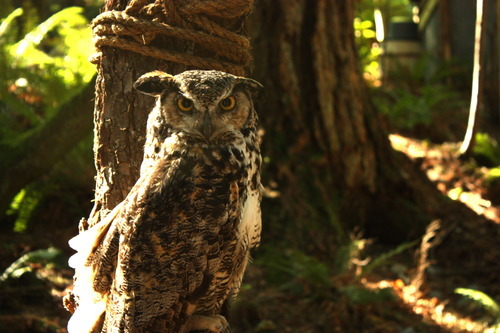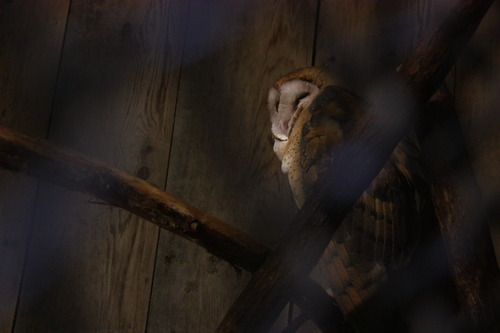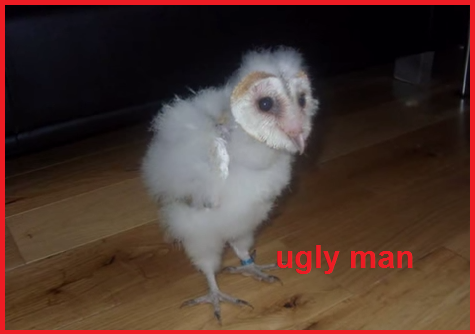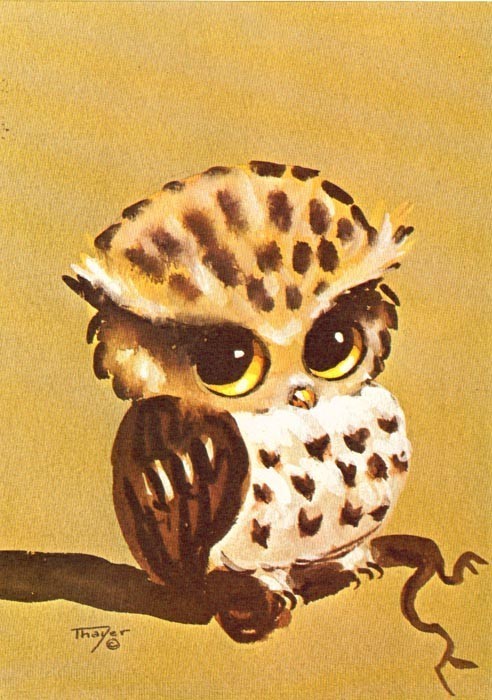#baby owl
This is Basket Owl (a baby great horned owl). Its mother, who is perhaps a first time mother, selected an old, very small (for an owl) crow nest at the top of a tree. Not surprising to the people watching her constantly pulling her baby back under herself as it bulged over the edges of the nest, the baby fell out when very young. Thankfully, some kind humans noticed and instead of absconding with the baby, they grabbed a new nest (a deep basket) and secured it part way up the nest tree, then placed the baby in the basket. Thankfully, mom realized this was a much better nest and resumed sitting on her baby in their new home. This is Basket Owl yesterday, several weeks after its rescue, doing well and in the “brancher” phase (i.e. not quite fledging, but moving around in the tree a bit). It’s such a cute puff and a testament to people trying to keep the baby with its parents instead of just kidnapping it with good intentions.
Please, if you encounter baby birds this season, do your best to place them back in the nest or up in a bush or tree, off the ground. Don’t immediately take the baby and accidentally kidnap it. If the nest seems to have broken, find a cardboard box or a small basket, place the baby inside, and secure it up in the nest tree, off the ground (the parents are very likely going to find it). If you feel the bird may be legitimately injured, call a bird expert or rehabber BEFORE taking the baby away from its parents.
Enjoy watching all the cute baby birds this season!
Post link
Halloween Owl
Baby owl is rescued and has his first bath
2013/08/03
In my line of work I repeat myself a lot, and that’s to be expected; the guests probably don’t think about the fact that I regurgitate the same info three hundred times a day. But one question that people ask has been getting to me a little bit: “Do you have any owls?”
The answer, most days, is yes. We do have owls. We just don’t have any owls here today. And to tell you the truth, at first the question sort of offended me. I mean, Jesus, is seeing hawks and falcons up close just not good enough for these people? Are they not beautiful? Do they not deserve the same awe and adoration?
I work with three owls:

Stomper, 6 y.o. female Barn Owl (Tyto alba)

Chico, 2 y.o. male Barred Owl (Strix varia)

Lucy, 11 y.o. female Great Horned Owl (Bubo virginianus)
I will not deny that they are some of my favourite birds to work with–my pottery signature is a doodle of a barn owl, fergodssake–because they are so private and so different from the others, but last week a sixteen-year-old girl pitched a fit complete with pouting and foot-stomping simply due to the fact that we didn’t bring in any owls that day. It really made me question, why does everyone sigh with adoration at the sight of a fussy nocturnal bird? Why is it that when we’re doing a hawk presentation, people are laughing and generally in a spirited mood while the minute we bring out an owl, voices drop to whispers, faces go solemn and parents shush their children?
Now, I’m no psychologist, but I have a few hypotheses.

When the Empress of Everything gives you a look, start groveling.
It’s common knowledge that most owls are active at night (though strictly speaking, their nocturnal nature is by no means compulsory; they can see ten times better than we can during the day), and thus are doing most of their errands when people are asleep. People tend to equate nighttime with mystery and furtiveness as well as with romance, especially where the moon and the stars are concerned. The image of a white barn owl cutting a streak through the night, looking itself like a sibling of the moon, definitely has some romance to it. Owls lead mysterious and very private lives, and I think the fact that they are seldom seen really gives them a sort of mythic air for a lot of people.
Another reason they might be so loved is that like us, their eyes face forward, their beaks fall away from their faces just like our noses, and some species even look to have eyebrows. It’s these similarities to our own features that makes the owl the most recognizable animal to children. Maybe it plays a part in why we find them so cute, because their expressions mirror our own, only…featherier.

Cheeky on his favourite perch; above everybody and perfect for narrowly missing me with poop.
One thing still sort of stumps me, though. Why have owls become so popular when in many cultures they are still feared as harbingers of bad luck and death? In a large part of Africa they are persecuted fiercely as “witch-birds”, many First Nations cultures in North America have severe taboos regarding owls–some even consider looking at an owl to be sure sign of death–and in the Arabian Peninsula owls are purported to carry off children and are haram (taboo) to eat under Muslim law. Even the western world has its superstitions: as late as the 1950’s dead owls were commonly nailed to barn doors in the UK and France to ward off lightning strikes and the evil eye. Interesting how in just 70 years, things have turned 180° and owl-mania has set in.
All this being said, I am fine with people loving owls. Actually, I love that people love owls. It makes me smile. It gives me hope that they’ll listen to the conservation advice that we give at the end of each presentation. But the one thing that drives me up the freaking wall, especially online, is people saying one of the following:
- “I want a pet owl.”
- “Having an owl would be so dope.”
- “How do you catch an owl? I want one sooooo baaaadddd.”
I realize what a losing battle responding to these people is, but I feel somehow responsible as a representative of the industry. You guys, owls can be pretty dreadful at times. Especially when they decide to sit on your head with these bad boys:

Stomper’s foot. It’s been on my head, and it sucked.
Owls are totally unlike any bird you will ever meet. Their behavior is different, their demands are different, they even fly differently. They tend to be a lot more difficult, especially once they are grown and established in their habits, and make really terrible pets.
Owl tantrums are a thing. And not just a sometimes thing. Some owls will flip a table every time you try to pick them up. Lucy is like that, and I have tremendous respect for that bird because she has 450 PSI of pressure in her feet and if she wanted to she could snap my ulna like a dry twig. Kim has been working with her for seven years and it took all of them to get her comfortable enough to sit for a few hours on his fist. Comparatively, he had Rusty, our rescued Red-Tailed Hawk, flying the length of the yard and back to him within 3 days of getting him from the rehab. Now that is a bit of an extreme comparison, but it can be commonplace for an owl to “shut down” on you seemingly at random and force you to start at square one again.

Owls generally don’t give a shit about anything but sleeping.
I see so many videos on Youtube of people with “pet” owls and it makes me so sad because I know that a lot of them will end up surrendering their owl to a falconer because it’s just too much work. This I say expecting the resounding echoes of “How dare you! I’m a great owner!” I wish I could believe you, but we see it every year: Karen gets the call from someone who got a permit, bought a bird and just couldn’t keep up the slack. Mind you, this mostly happens with hawks as in this province there are only a handful of people who have permits for owls but the principle is the same. Once an owl, no, ANY animal imprints on you, you have a responsibility to that animal. When another life is involved, fall in love with your head before you do with your heart.

The worst.
And if you really want to help owls, there are fortunately plenty of things that you can do! Barn Owl numbers are dropping at an alarming rate, so encourage nesting by building and installing a Barn Owl box (pattern here). Volunteer at your local rehab to promote breeding programs and re-release. That being said, the number one thing you can do is to stop using rat poison. Tell your friends, tell your neighbours; rodenticides are the leading cause of raptor death in the world today, and with fewer owls, the rodent population only continues to climb. And poisons don’t just affect wild animals: say your dog runs off into a bush while you’re walking with them and eats part of a dead owl. A week later, your dog dies of internal hemorrhage. Your kid picks up a stick, pokes the dead owl, touches the end of the stick, touches his mouth, he gets sick too.
The owls are doing their best, so it’s up to us to keep our lifestyles owl-positive. I have lost count of the people I see every day who are moved by the beauty of these enigmatic animals, and I hope that those people will spread the word.

Seriously though, grow a pair and switch to snap traps.
Sources:
http://www.bbc.co.uk/news/science-environment-21279609
http://www.owlpages.com/articles.php?section=owl+mythology&title=World
Owl practicing hunting
(via)






